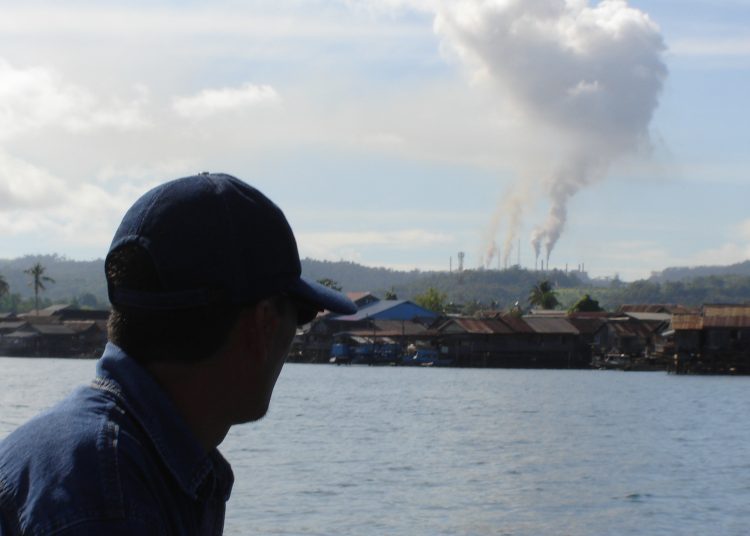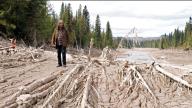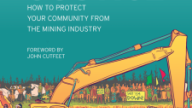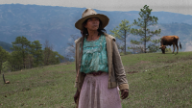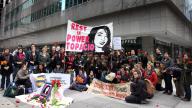by Tracy Glynn. Originally published by the New Brunswick Media Co-op here.
The shift to electric vehicles is sparking considerable new demand for metals and minerals, which some feel Canada should rush to fill. That is the argument Martin Wightman articulated in The Daily Gleaner on Nov. 15. However, mining watchdog groups, most recently at the UN climate conference, COP26, say that we can’t mine our way out of the climate crisis and that Canadian mining is doing more harm than good.
After expressing concern that China is controlling the global critical minerals supply, Wightman mentions the atrocities in Congolese mines then claims Canadian mining companies have a relatively safe track record. While mining in Canada may be relatively safer than when my 52-year old great-grandfather did not come home from a shift at the coal mine in Minto, New Brunswick in 1950, mining continues to be a dangerous industry for workers and communities.
As heavy rainfall, severe flooding and mudslides devastate parts of British Columbia, residents there must worry about the dams holding enormous amounts of mine waste. It was only seven years ago that an estimated 24 billion litres of toxic slurry poured out of the Mount Polley dam, scouring old growth forest for 10 kilometres in British Columbia’s central interior Caribou region.
The Mount Polley spill, what the industry and government called an “impossible event,” occurred in the middle of the night on August 4, 2014. No one was killed in one of the largest tailings spills in North American history unlike the world’s largest tailings spill that happened at Vale’s Brumadinho dam in Brazil on January 25, 2019. The dam collapsed at lunch time and 270 people perished.
For Nuskmata (Jacinda Mack) and the people of Xatśūll First Nation, the Mount Polley spill felt like a death in the community: “Our people are grieving. My grandchildren will never know what it’s like to swim and fish in Quesnel Lake. That’s their inheritance, part of our bloodline now.”
Today, located within or near British Columbia’s “Evacuating Alert Flooding Zone” are mine waste sites at the operating Highland Valley Copper Mine, and the closed Giant Nickel Pride of Emory Mine and Brenda copper-molybdenum mine.
Canada has an estimated 10,000 abandoned mines and while closed, many of them have not stopped polluting. While many mines in Canada do not operate longer than 10 to 15 years, digging up toxic chemicals such as arsenic requires perpetual maintenance. Canada has yet to reckon with many of these abandoned mine sites in a way that seriously considers climate change and increased extreme weather events.
Making electric vehicles will require more nickel, copper, aluminum, cobalt and lithium. Rich deposits of the so-called “key energy transition metals” are found in northern Ontario’s Ring of Fire region on Indigenous territory. The Ring of Fire project has divided communities. Eabametoong First Nation Chief Elizabeth Atlookan said, “The development of our homelands is about more than any one mine or road, it’s about the potential transformation of our lands and way of life–forever.”
Besides being concerned about mining in Canada, Canadian mining around the globe has become such a concern that there are entire organizations devoted to bearing witness to the struggles of people harmed by Canadian mining companies. They include MiningWatch Canada, the Canadian Network for Corporate Accountability, the Mining Injustice Solidarity Network and groups active right here in Fredericton like the Maritimes-Guatemala Breaking the Silence Network.
When we talk about atrocities of mining in the Democratic Republic of the Congo, we must remember who stands accused of having committed atrocities in the past. They are Canadian mining companies: Banro Gold, First Quantum Minerals and Anvil to name just three.
Oftentimes, Canadians learn about the struggles because lawyers such as Ottawa-based Murray Klippenstein make headlines for taking on historic cases such as Angelica Choc v. HudBay Minerals Inc. Choc says that her husband, Adolfo Ich, a community leader and teacher, was hacked with machetes and shot in the head by mine company security personnel on Sept. 27, 2009. In the case, Margarita Caal Caal v. HudBay Minerals Inc., Klippenstein’s firm is representing 11 women who say they were gang-raped by mining company security personnel, police and military during the forced eviction of their village and families from their ancestral lands on Jan. 17, 2007.
With more than 60 per cent of global mining companies headquartered in Canada, these are just a few stories of abuses at Canadian-owned mine sites.
Books that powerful mining companies have tried to censor, such as Noir Canada: Pillage, corruption et criminalité en Afrique by Alain Deneault in collaboration with Delphine Abadie and William Sacher, and the recently published Testimonio: Canadian Mining in the Aftermath of Genocides in Guatemala, edited by Catherine Nolin and Grahame Russell, document the systematic nature of crimes committed by Canadian mining companies abroad.
When RCMP officers show up at a university launch of mining critic Joan Kuyek’s book, Unearthing Justice: How to Protect Your Community from the Mining Industry?, we all must ask, what crime do they think they are preventing? The spread of information about the social and environmental costs of mining?
Now, Canadian mining companies speak of being part of the just energy transition; they are going to mine our way out of the climate crisis. Their just energy transition plans include mining the seabed for lithium, copper, manganese, nickel, and cobalt to make electrical vehicles.
Wightman is right: More electrical vehicles will mean more mining, but it will also mean more displaced communities, and more violence when people don’t want their lands taken for the mining of metals for car batteries. Let’s not forget the large carbon footprint of manufacturing electrical vehicles, which includes emissions from mining the metals for the car’s steel body and batteries.
I have spent the last two decades documenting a long list of social and environmental impacts of just one large-scale nickel mine and smelter on the Indonesian island of Sulawesi. Now, the nation of islands says it wants to immediately open dozens more nickel mines and smelters to meet the demand for nickel in electric vehicle batteries. The plans include dumping mine waste into the ocean, threatening the livelihoods of fisherfolks and protein sources of entire communities.
Besides dumping waste into the ocean to save us from climate change, mining companies want to mine the ocean floor where the deep-sea corals, sea urchins, starfish, octopus and undiscovered live.
The Metals Company, formerly DeepGreen Metals, of Toronto, wants to mine the Pacific seabed’s polymetallic nodules that are rich in cobalt, nickel and copper for electric vehicles. In 2019, the Pacific island nation Nauru broke UN protocol by ceding its seat to DeepGreen’s chief executive, Gerard Barron, at a meeting of the International Seabed Authority Council. So, who runs the nation of Nauru?
The pressing question that is before us is how do we address the climate emergency when powerful mining companies are taking advantage of the crisis at the expense of the livelihoods and lives of people.
When Obama says the world needs more Canada and Wightman says that Canada needs to take more control of the global critical minerals supply, I am reminded of the Maya Q’eqchi’ people of Guatemala who say the opposite. They have told us to not wear a Canadian flag on our backpacks for our own safety because Canadians are not welcome. Canadians are not welcome because of how Canadian mining companies like Inco Ltd. have been implicated in the 1978 Panzos Massacre and targeted assassinations of a Congressman, peasant farmers, lawyers, professors and students, all documented in the 1997-1999 UN Truth Commission Report on Guatemala, and Jamie Swift’s The Big Nickel.
Severe repression around Canadian-owned mine sites continues today. Topacio Reynoso Pacheco was 16 years old when she was fatally shot in 2014. The family of the Metallica-loving teenage poet, all opponents of the Escobal silver mine, the world’s third largest, hold the owner Tahoe Resources responsible for Topacio’s murder.
Land defenders in the lithium triangle of Argentina, Chile and Bolivia are telling us, “we don’t eat batteries.” Nuskmata, in the wake of the Mount Polley disaster, told us, “Our economy walks on the land and swims in the river.” As the British Columbia government sends in the RCMP to violently remove Wet’suwe’ten land defenders opposing a gas pipeline on their territory, we must demand climate solutions that protect people and precious ecosystems that provide food, water, medicines and livelihoods.
Suggestions that the world needs more colonial extractions to solve the climate crisis are just another symptom of the problem, not a solution.
Tracy Glynn is an assistant professor in the Environment and Society program at St. Thomas University. She engages in research and solidarity work with land defenders in Indonesia, Guatemala, Colombia and beyond.
